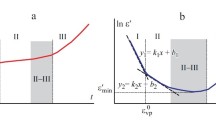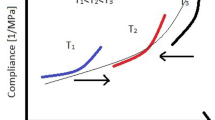Abstract
An experimental study of a tensile loading–unloading procedure, as well as multi-cyclic response in a strain-controlled program of a Styrene-Butadiene (SBR) elastomer reinforced with four different weight fractions of carbon nanotubes (CNTs) has been performed. The Mullins effect features, namely hysteresis, damage and residual strain, exhibited by the SBR/nanocomposites were analyzed by a modified Gent–Zener rheological model, and a damage function. Especially for the multi-cyclic stress–strain curves, phenomenological equation of the model parameters evolution with strain were also introduced. The same loading procedure was applied in pre-stressed materials, revealing a different stress–strain response due to strain prehistory. The model has been proven to accurately capture the loading–unloading behavior, the residual strain, hysteresis loops as well as the multi-cyclic behavior of the SBR/CNT nanocomposites.









Similar content being viewed by others
References
Flügge W (1967) Viscoelasticity. Blaisdel Publishing Company, Waltham
Christensen RM (1982) Theory of viscoelasticity: an introduction. Academic Press, New York
Green AE, Rivlin RS (1957) The mechanics of nonlinear materials with memory part I. Arch Ration Mech Anal 1:1
Findley WN, Onaran K (1968) Product form of kernel functions for nonlinear viscoelasticity of PVC under constant rate stressing. Trans Soc Rheol 12:117–242
Lockett FJ (1972) Nonlinear viscoelastic solids. Academic Press, London
Smart J, Williams JG (1972) J Mech Phys Solids 20:313–324
Caruthers JM, Adolf DB, Chamberd RS, Shrikhande P (2004) A thermodynamically consistent nonlinear viscoelastic approach for modeling glassy polymers. Polymer 45:4577–4597
Schapery RA (1997) Nonlinear viscoelastic and viscoplastic constitutive equations based on thermodynamics. Mech Time Depend Mater 1:209–240
Tervoort TA, Klompen ETJ, Govaert LEJ (1996) A multi-mode approach to finite, three dimensional nonlinear viscoelastic behavior of polymer glasses. Rheology 40(5):779–797
McKenna GB, Zapas LJ (1980) The normal stress response in nonlinear viscoelastic materials: some experimental findings. Soc Rheol 24(4):367–377
Papanicolaou GC, Zaoutsos SP, Cardon AH (1999) Prediction of the nonlinear viscoelastic response of unidirectional fiber composites. Compos Sci Technol 59:1311–1319
Khan AS, Lopez-Ramies O, Kazmi R (2006) Thermo-mechanical large deformation response and constitutive modeling of viscoelastic polymers over a wide range of strain rates and temperatures. Int J Plast 22:581–601
Guedes RM (2010) Nonlinear viscoelastic analysis of thick-walled cylindrical composite pipes. Int J Mech Sci 52:1064–1073
Papanicolaou GC, Xepapadaki A, Abiramia G, Jiga G (2008) Viscoelastic characterizationof a glass-epoxy composite. Mater Plast 45:221–227
Haward RN, Thackray G (1968) The use of mathematical model to describe isothermal stress-strain curves in glassy polymers. Proc Lond Ser Soc A302:453–472
Boyce MC, Parks M, Argon AS (1988) Large inelastic deformation of glassy polymers part I: rate dependent constitutive model. Mech Mater 7(1):15–33
Boyce MC, Arruda EM (1990) An experimental and analytical investigation of the large strain compressive and tensile response of glassy polymers. Polym Eng Sci 30:1288–1298
Wu PD, van der Giessen E (1993) On improved network models for rubber elasticity and their application to orientation hardening in glassy polymers. J Mech Phys Solids 41:427–456
Khan AS, Baig Muneer, Hamid Syed, Zhang Hao (2010) Thermo-mechanical large deformation responses of hydrogenated nitrile butadiene rubber (HNBR): experimental results. Int J Solids Struct 47:2653–2659
Fatt MSH, Xin Ouyang (2008) three-dimensional constitutive equations for styrene butadiene rubber at high strain rates. Mech Mater 40:1–16
Zacharatos A, Kontou E (2015) Nonlinear viscoelastic modeling of soft polymers. J Appl Polym Sci. https://doi.org/10.1002/app.42141
Mullins L, Tobin NR (1957) Theoretical model for the elastic behavior of filled- reinforced vulcanized rubber. Rubber Chem Technol 30:555–571
Bueche F (1960) Molecular basis for the Mullins effect. J Appl Polym Sci 4:107–114
Govindjee S, Simo JC (1991) A micro-mechanically based continuum damage model for carbon black-filled rubbers incorporating Mullins’ effect. J Mech Phys Solids 39(1):87–112
Mullins L (1969) Softening of rubber by deformation. Rubber Chem Technol 42:339–362
Ogden RW, Roxburgh DG (1999) A pseudo-elastic model for the Mullins effect in filled rubber. Proc R Soc Lond A 455:2861–2877
Zúňiga AE, Beatty MF (2002) A new phenomenological model for stress—softening in elastomers. Z Angew Math Phys 53:794–814
Diani J, Fayolle B, Gilormini P (2009) A review on the Mullins effect. Eur Polym J 45:601–612
Drozdov AD, deC Christiansen J (2011) Mullins’ effect in semicrystalline polymers: experiments and modeling. Meccanica 46:359–370. https://doi.org/10.1007/s11012-010-9314-z
Drozdov AD, Clyens S, Theilgaard N (2013) Multi-cycle deformation of silicone elastomer: observations and constitutive modeling with finite strains. Meccanica 48:2061–2074. https://doi.org/10.1007/s11012-013-9725-8
Klüppel M (2003) Filler-reinforced elastomers/sanning force microscopy. In: Abe A, Dušek K, Kobayashi S (eds) Advances in polymer science, 1st edn, vol 164. Springer, Berlin
Qi HJ, Boyce MC (2004) Constitutive model for stretc-induced softening of the stress-stretch behavior of elastomeric materials. J Mech Phys Solids 52:2187–2205
Dargazany R, Itskov M, Junwei Liu J (2010) Microstructural changes of filled rubber-like materials under cyclic loading. PAMM, Proc Appl Math Mech 10:289–290. https://doi.org/10.1002/pamm.201010137
Dargazany R, Itskov M (2013) Constitutive modeling of Mullins effect and cyclic stress softening in filled elastomers. Phys Rev 88:012602
Mai Thanh-Tam, Morishita Yoshihiro, Urayama Kenji (2017) Novel features of the Mullins effect in filled elastomers revealed by stretching measurements in various geometries. Soft Matter. https://doi.org/10.1039/c6sm02833k
Tauheed Firozut, Sarangi Somnath (2014) Damage-induced stress–softening and viscoelasticity of limited elastic materials. Mech Time-Depend Mater 18:493–525. https://doi.org/10.1007/s11043-014-9239-3
Zúňiga AE, Rodríguez CA (2010) A non-monotonous damage function to characterize stress–softening effects with permanent set during inflation and deflation of rubber balloons. Int J Eng Sci 48:1937–1943
Calva V (2008) Characterization of the stress–softening and permanent set effects of elastomeric materials. M.S Thesis, Tecnologico de Monterrey, Campus Monterrey
Khan AS, Huang S (1995) Continuum theory of plasticisty. Wiley, Hoboken
Georgousis G, Pandis C, Chatzimanolis-Moustakas C, Kyritsis A, Kontou E, Pissis P, Krajči J, Chodák I, Tabačiarová J, Mičušík M, Omastová M (2015) Study of the reinforcing mechanism and strain sensing in a carbon black filled elastomer. Compos B 80:20–26
Author information
Authors and Affiliations
Corresponding author
Rights and permissions
About this article
Cite this article
Kontou, E. Stress–softening effect of SBR/nanocomposites by a phenomenological Gent–Zener viscoelastic model. Meccanica 53, 2353–2362 (2018). https://doi.org/10.1007/s11012-017-0812-0
Received:
Accepted:
Published:
Issue Date:
DOI: https://doi.org/10.1007/s11012-017-0812-0




